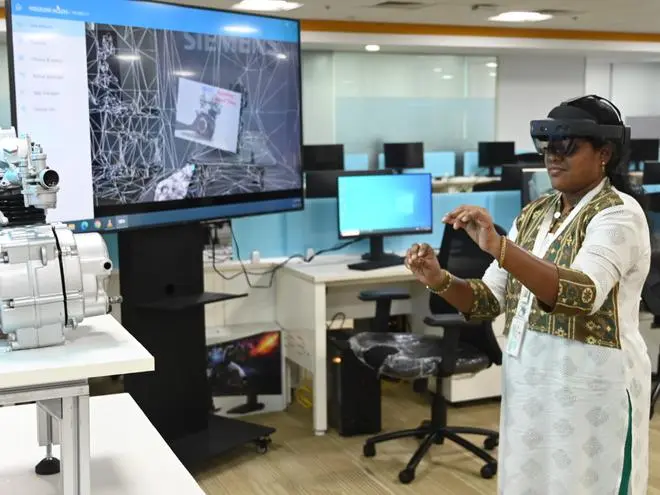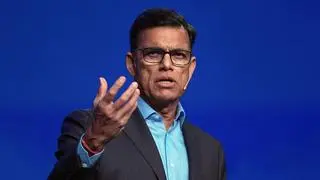Wearing large AR glasses, covering half her face, Janani Ravichandran, an AR (augmented reality) engineer, is gesticulating mid-air, twisting buttons, pressing knobs virtually, before she lays hands on a two-wheeler engine. She gets to work pulling out some parts effortlessly, tweaking bolts and nuts, guided by the hololens she’s put on. It’s all part of a simulated maintenance drill.
Sukhpreet Singh, Head, Tamil Nadu Smart and Advanced manufacturing Centre, or the TANSAM Siemens Centre of Excellence, at the Tidel Park, one of the earliest software parks in Chennai, points out that Janani is demonstrating remote guided maintenance.
Singh says that many industries can use now AR for equipment maintenance and repair. “A technician, through the hololens, which has a camera, aims it at a machine. The electrical wiring of the system displays relevant notes and videos with voice-over pops-up alongside the screen, which the user can see, and attend to a machine. Somebody even sitting in Japan can see what Janani is seeing through the camera’s hololens and guide her,” he explains.

AR for equipment maintenance and repair can help technicians identify problem areas quickly and reduce downtime
With this technology, a technician can also identify the problem area more quickly and reduces downtime. The hololens AR method, Singh says, can be used for maintenance in defence, aerospace, process industries and also for complex machinery where experts cannot get to a site immediately for repairs.
Nurturing innovation
Over 2021-22, in a unique initiative, the TN government, through the Tamil Nadu Industrial Development Corporation (TIDCO), established three Centres of Excellence at Tidel Park, each tying up with different MNC majors, to provide cutting-edge tech and learning for the state’s MSMEs and start-ups which want to leverage the TN defence industrial corridor that is sprouting up.
All with rather similar names, TN Centre of Excellence for Advanced Manufacturing, has been set up with Dassault Systemes (TANCAM) at an investment of ₹211.97 crore; TANSAM, in a tie-up with Siemens (investment ₹252 crore); and TN Advanced Manufacturing Centre of Excellence, TAMCoE, in a tie-up with GE Aviation (₹141.26 crore). The CoEs were inaugurated by Tamil Nadu Chief Minister MK Stalin last year.
“The idea is to bring in deep tech to TN for the MSME sector and start-ups; the software the partners bring are too expensive for them to buy and that’s why the government thought to set up these centres of excellence so that the MSMEs would have access to advanced manufacturing techniques and software. These are unique centres; the idea is for start-ups to try out their models and prototypes here at a fraction of the costs and see what works for them,” explains Jayashree Muralidharan, Managing Director, TIDCO.
With the TN government in the process of establishing a defence corridor, spread over five nodes of Chennai, Coimbatore, Hosur, Salem and Tiruchi, TIDCO was given a mandate to conduct a study and identify the sectors where skills have to be honed, especially in the areas of aerospace and EVs to health and digital printing for metal parts.
“This will help a spectrum of industries; start-ups to MSMEs, for designing any component will be easier. Incubation of ideas can be done in these centres and because of the design software and the digital printing, prototyping will also be cheaper and faster; these technologies can cut across the entire industry,” says Muralidharan.
Making tech accessible
TANSAM’s Singh, holds up the prototype of a knee joint digitally printed in metal at the centre. Knee joints to hip joints, prototypes can be made with speed here and samples sent out before they’re actually made for use. Similarly, prototypes for other industries like auto components, joints, bolts, nuts et al can be made as well, Singh points out.
Apart from software solutions from Siemens, this CoE has 3D printers, cobots (collaborative robots); inspection equipment, VR/AR, scanners to enable training on software along with real-life applications. A young AR engineer is examining the anatomy of a human body wearing VR glasses; the AR programme allows him to hover over different body parts, separate rib cages and examine organs, scrutinise layers of muscles over bones. With the click of a mouse, you get complete information about the part. A useful tool for would-be doctors.
A robotic arm: A collaborative robot or cobot augments work and helps with assembly, inspection, palletizsation, welding, pick and place operations, physiotherapy, and so on.
With the use of VR one can actually have a much better understanding of each body part, that too in 3D. The immersive experience after wearing the Oculus leads to learning about each body part and its present positioning in the human body, says Singh.
Take the case of Shahnawas, a young Salem-based entrepreneur, who has worked in a few auto companies earlier. Trying to secure an order from an MNC truck maker for the outer panel of its lights, he connected with TANSAM through LinkedIn and developed a digitally-printed prototype, instead of going through a traditional die-maker and then metal moulding his part. Shahnawas says he is impressed with the accuracy he got from the first prototype. The CoEs, he says, are good news for young entrepreneurs like him.
AR engineer at work at the Siemens Centre of Excellence
Elaborating on the Siemens association with TIDCO, Mathew Thomas, MD and Country Manager for India, Siemens Digital Industries Software, says, as part of the TN government initiative of establishing a defence corridor, it was looking for technology partners who could provide support to these organisations, as well as defence, MSMEs, and start-ups in their digital journey and also build skills to support them long term.
“This centre would support sectors like aerospace, electric vehicle (EV), marine, green energy, biotech, industrial automation, robotics, and others. As an innovation leader, we think ahead to the next level of digital transformation — and integrate cutting-edge technologies such as AI, edge computing, cloud computing, industrial 5G, blockchain and additive manufacturing into our Xcelerator platform. With this we bring together the digital and physical worlds to benefit customers,” explains Thomas. SMEs, he says, will be the greatest beneficiary of this Xcelerator platform as it can help them scale up, upgrade and adopt new designs and components much faster.
B Krishnamoorthy, Special Secretary and Project Director, TIDCO, who oversees these initiatives, says this will help a spectrum of industries. “Our objective is to develop emerging technologies. They can have a transformative impact in each industry, textiles to chemicals, and can meet the requirements of different industrial clusters,” he says.
Bridging gaps
In another unique move, the MNCs have opted to have a local operating partner to run the CoEs and give it focus. The Siemens CoE is managed by Broadline Computer Systems for three years while Muthu Soft is with Dassault; GE has no operating partner as of now. “We don’t have any financial commitment with the operating partner. This model will see the COEs sustain,” adds Krishnamoorthy.
A Balamurugan, Vice-President, TIDCO, takes us to TAMCOE, set up by GE. This is a specialised 3D additive printing centre, which is a large closed unit in a completely fireproof and insulated air-conditioned hall. This unit, Balamurugan says, is geared for making metal parts with a post-processing unit. “The safety features and the facility here will be difficult for anyone to replicate,” he says.
S Saravana Kumar, Senior Programme Manager, GE Aerospace and TAMCoE programme head, says the GE centre is equipped for mass production of any parts through additive manufacturing, which essentially creates parts layer by layer. “This a state-of-art 3D printing facility for metal printing, starting from design to printing and post-processing, to inspection, we are self-dependent. Most critical processes are in-house. Somebody comes to us with a part made by traditional manufacturing, we can analyse it, convert from traditional to additive manufacturing, and produce it here,” he explains.
GE’s additive printing unit at TAMCoE
Saravana Kumar refers to one of the components that GE Aerospace space makes, which consists of 700 parts. “We have done this as one single part through additive printing, eliminating all bolts and nuts and this will have a higher level of tolerance,” he says. This technology is also very useful in auto and health industries, apart from defence. “We have a lot of auto companies in and around Chennai; if they need a complex design we can work with them or their MSME suppliers to convert it into a useful product,” he explains.
Boosting manufacturing economy
For healthcare, Saravana Kumar says 3D printing can be fast and effective, especially for those having an operation for their joints. Now, either one is dependent on parts from Europe, or a tool has to be made, then, say a knee joint, has to be cast, usually in titanium. “Overall, for a knee joint operation, from diagnosis to a replacement, it could take six months, but now with this technology, once the scans are given, we can print it in just 10 days.” However, he cautions, that in India one still needs approvals for making such parts.
For new product introduction in aeropsace and automobile industries, rapid prototyping can be done in this facility. “We have done lots of research in our Bengaluru centre and that knowledge can be transferred here — frames, brackets, blocks to bolts can be made immediately, for non-critical applications,” he says. The facility can use cobalt chrome and Inconel for its 3D printing and Kumar says the new centre is in talks with various vendors to design their parts.
TIDCO’s MD, Jayashree Muralidharan, says apart from giving a leg-up to the industry in new technologies, the other part is awareness. “We have to popularise it and let people know what is available. We have been sending out emails to various industry clusters to let them know such facilities exist.” That apart there is a huge outreach to students and faculty of engineering colleges to experience these facilities so students can be made aware of the latest tech and also seek out qualifications the tech industry wants.
Muralidharan points out that TN has among the highest gross enrollment ratios in higher education but “unfortunately, even though we have a highly educated workforce, many lose out because they don’t have the necessary soft skills and employable skills. With these CoEs, we expect to upgrade student skills,” she says.
“We strongly believe this will give a boost to the manufacturing economy. For TN, manufacturing’s contribution is 20 per cent (of GSDP) while the national average is 16 per cent (of GDP). We strongly believe this will give a big boost to manufacturing,” she says. Tech can be the big differentiator







Comments
Comments have to be in English, and in full sentences. They cannot be abusive or personal. Please abide by our community guidelines for posting your comments.
We have migrated to a new commenting platform. If you are already a registered user of TheHindu Businessline and logged in, you may continue to engage with our articles. If you do not have an account please register and login to post comments. Users can access their older comments by logging into their accounts on Vuukle.